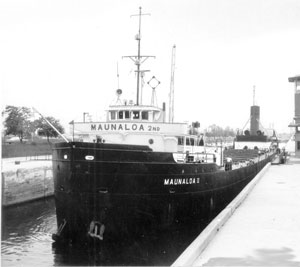
Shipwreck: Maunaloa II
by Skip Gilham, Vineland, Ontario, Canada
 |
The Maunaloa II in Port Colborne, June 16, 1971. |
Maunaloa II had a long and diverse career on both sides of the Great Lakes. The ship was part of the largest American fleet of lakers ever assembled and later joined the second largest fleet on the Canadian side.
The ship was built in Chicago and launched on August 12, 1899. It was designed to be the steamer Tennessee, but it was sold prior to completion and joined the Minnesota Steamship Company as the ore carrier Maunaloa.
Measuring 452 feet long by 52 feet, 3 inches wide, the 4,951 gross ton freighter was equipped with a powerful 2,000 horsepower quadruple expansion engine. The coal burning steamer had four cargo holds that were serviced by 13 hatches.
Maunaloa went to work in the ore trade, but this was a time of change in the steel industry. In 1900, the vessel moved under the banner of Federal Steel, and the next year it was one of 112 vessels to form the initial Pittsburgh Steamship Division of the newly created United States Steel.
It was not unusual in those days to have powerful freighters tow cargo laden barges. Wood steamers often pulled old schooners while a new type of consort barge was constructed to work with the increasingly larger lakers. Such consorts were similar in size and capacity but only required about half the number of crew.
Maunaloa was often engaged to pull a barge and got into trouble doing this on October 13, 1902. With the ore laden BARGE 129 in tow, Maunaloa was crossing Lake Superior, buffeted by a fall gale, when the towline parted. The freighter turned to reconnect, but on the approach Maunaloa's port anchor ripped open the hull of the powerless vessel. BARGE 129 sank quickly, but all on board were saved.
The next year Maunaloa collided with the tug Edward Gillen off the Superior entry on May 18; the smaller vessel sank with the loss of one life.
Other than the two early incidents, Maunaloa had a long a productive career. It provided vital supplies of iron ore through two World Wars and survived the Depression era when many smaller ships were tied up for good.
The vessel was rebuilt in 1922, with the pilothouse being moved forward instead of at a location between the first and second hatch. A "doghouse" for larger crew accommodation then occupied the spot where the pilothouse had been.
At the end of World War Two, this ship was sold to the Upper Lakes and St. Lawrence Transportation Company into Canadian registry as Maunaloa II. This company dated from 1931 and grew into the second largest Canadian fleet on the inland seas. It continues to provide service for customers as Upper Lakes Shipping.
Maunaloa II now concentrated in the transportation of grain, continued to pull consort barges for another fifteen years, and then carried on alone.
During part of this period, from 1949 to 1965, the vessel carried 395 cargoes or an average of just over 23 trips a years. Most cargoes (335) were various grains but the ship also hauled ore (47), coal (10), salt (2) and stone (1).
Prior to 1959 the ship was confined to the five Great Lakes, but, when the St. Lawrence Seaway opened in 1959, large vessels like Maunaloa II could now trade down the St. Lawrence. It made its first transit of the new waterway in August 1959, taking grain to Trois Rivieres and Quebec City and then loading iron ore at Contracoeur for Cleveland. The ship made a single trip to Baie Comeau in 1961, and three to Trois Rivieres in 1962 before leaving the Seaway and returning to the Great Lakes for good.
In the later years, Maunaloa II primarily hauled grain to the Lake Huron port of Goderich with occasional diversions to Collingwood, Midland or Milwaukee. The last cargo was delivered to Toronto on June 17, 1971, and the vessel departed the next day for the scrap yard at Hamilton, Ontario. Work on breaking up the veteran freighter was completed in May 1972.
Page last modified: